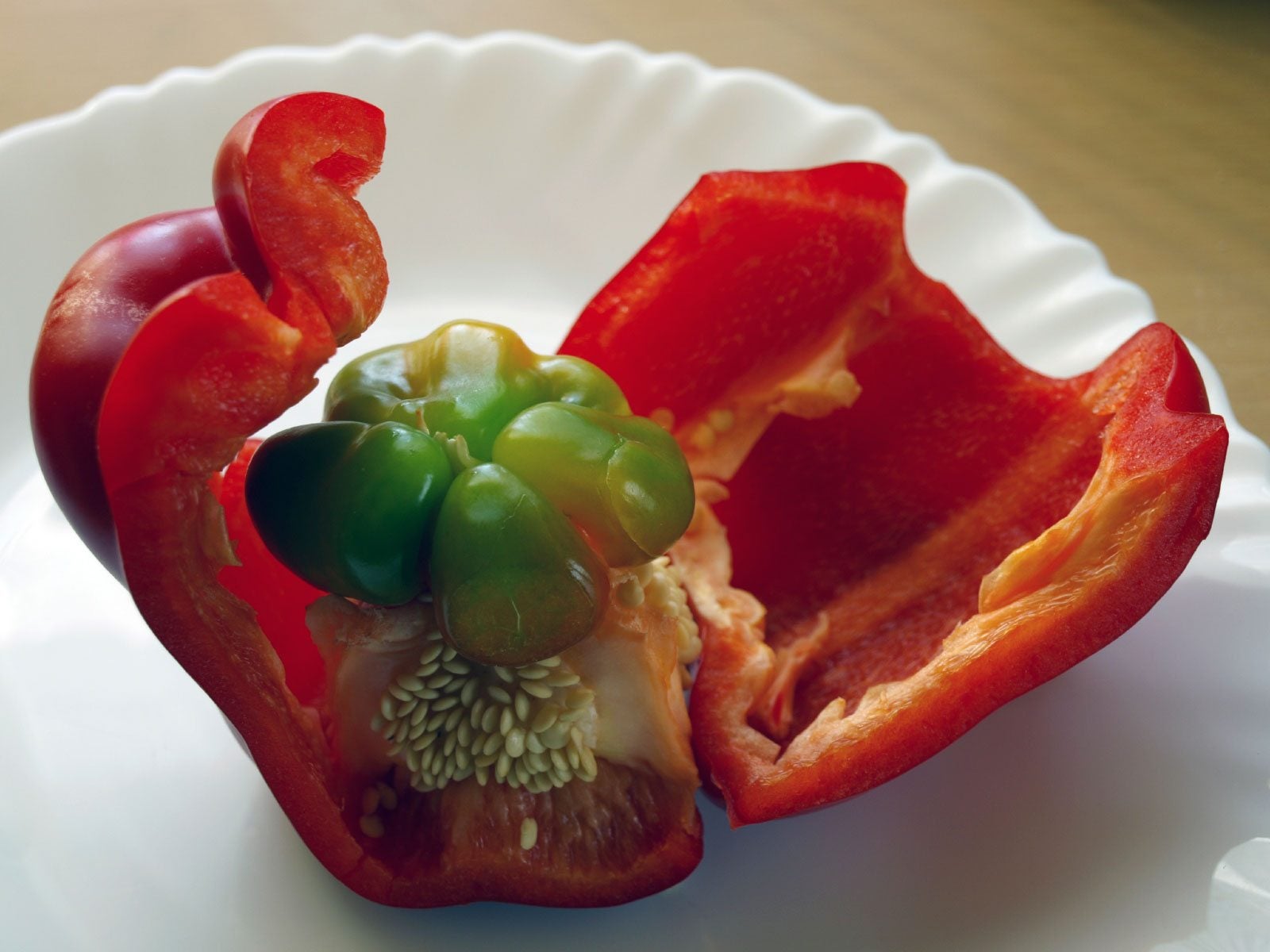It’s pretty common to cut into a bell pepper and find a small pepper inside the bigger pepper. You may be wondering, “Why is there a small pepper in my bell pepper?” Read on to find out what makes a pepper have a baby pepper inside it.
As a vegetable gardener, I love growing all sorts of peppers each summer. The rainbow of colors and range of heat levels means there’s always a pepper variety suited for any recipe. However, every so often when harvesting my peppers, I’ll discover a strange surprise – a tiny pepper growing inside a larger pepper! The first time this happened it really threw me for a loop. But after doing some research, I learned this odd occurrence is completely natural and the peppers are perfectly safe to eat.
In this article, we’ll take a closer look at the phenomenon of smaller peppers developing inside full size peppers. Learn what causes these inner peppers to form, whether it impacts flavor or quality, and what you should do if you find one growing in your own garden.
What Exactly Causes Peppers to Grow Inside Peppers?
So what leads to these mini pepper oddities forming within regular peppers? The answer has to do with a process called parthenocarpy.
Parthenocarpy is when fruits like peppers develop without pollination and fertilization taking place. Under natural conditions, pollen produced by the plant reaches the female ovary and fertilizes the ovules. The ovules then develop into seeds inside the chamber of the fruit.
But in some cases likely due to genetic traits or environmental factors errors occur during pollination. When this happens, one or more ovules may not be successfully fertilized. Rather than forming seeds, these ovules then develop into actual pepper tissue instead.
This misguided ovule growth leads to the smaller pepper structures appearing among the normal seeds. They start as tiny clusters of cells that gradually take the shape of peppers as the fruit matures on the plant.
The exact trigger for parthenocarpy in home gardens is not fully understood. But it seems completely random and is not harmful or indicative of any issues with your peppers. Just an unusual natural occurrence!
Does Finding a Pepper Inside a Pepper Impact Quality or Flavor?
Rest assured that discovering a mini pepper inside your regular pepper does not make it unsafe to eat or impact quality. That includes both the large outer pepper and the smaller inner pepper.
The internal structures are edible pepper tissue just like the rest of the fruit. I have tasted them, and they blend seamlessly with the flavor of the whole pepper.
In some cases, the inner pepper may have a slightly different texture since it formed in a unique way. But taste and nutrition remain unaffected.
And since these inner peppers do not contain seeds, they are essentially seedless pepper varieties. Their seedless nature is perfectly normal for how they developed.
Bottom line – do not worry if you cut open a pepper and find another tiny pepper inside! It is 100% safe to eat both pieces and does not indicate any issues.
What to Do if You Find a Pepper Growing Inside Your Pepper
When you discover one of these fascinating pepper oddities, there are two ways you can proceed:
- Eat both peppers! This is what I do since the inner pepper provides a bit of extra edible material. Simply slice both peppers as you normally would and add them to your planned recipe.
- Remove the inner pepper if desired. For appearance purposes in certain dishes, you may opt to gently cut away the smaller inner pepper and just use the regular outer one. But the inner pepper certainly doesn’t need to be discarded – you can eat it separately.
That’s really all there is to it if you stumble upon peppers growing inside your own peppers! Apart from marveling at the quirks of nature, you can rest easy knowing they pose no risks and tend to be quite tasty.
Why Do Some Pepper Varieties Develop Inner Peppers More Often?
While any pepper can potentially form internal peppers, some varieties do seem more prone to it. According to vegetable growing experts, bell peppers and smaller sweet peppers appear especially susceptible.
In particular, cultivars derived from the Maor variety are known for producing internal peppers frequently. Maor breeding stock contributes genetics to many modern sweet pepper selections. The trait for parthenocarpy seems to be passed down.
Hot pepper varieties like jalapeños, though possible, do not tend to develop internal peppers as regularly. Their chemistry and genetics differ from sweet bell peppers, making the irregular fruit formations less expected.
Growing conditions may also influence the likelihood of inner peppers occurring. For example, fluctuations in temperature seem to increase cases in some pepper crops. However, home garden environments make pinpointing causes difficult.
No Need to Worry About This Garden Oddity!
While mini peppers growing inside normal sized peppers may look strange, they are simply an example of nature’s imperfections. If you find them in your own garden one day, have fun showing them off!
Rest assured there are no safety or quality issues involved with inner peppers. Their unique appearance stems from the ovules developing abnormally during the fruit formation process. But flavor and edibility remain untouched.
Hopefully this overview gives you a better understanding of what causes peppers to occasionally grow inside other peppers. Beyond providing a conversation piece, they also give you some bonus edible material. So savor these quirky garden discoveries if you are lucky enough to stumble upon them!

Pepper Growing in a Pepper Phenomenon
Internal proliferation occurs among many seeded fruits from tomatoes, eggplants, citrus and more. It seems to happen most often with fruit that was picked before it was ripe and then ripened in a lab using ethylene gas before being sold.
During the normal development of bell peppers, seeds develop from fertilized structures or ovules. There are many ovules inside the pepper. These turn into tiny seeds that we throw away before eating the fruit. When a pepper ovule gets a wild hair, it grows an internal growth called carpelloid formation that looks more like the parent pepper than a seed.
Normally, fruit forms if ovules have been fertilized and are developing into seeds. On occasion, a process called parthenocarpy occurs wherein the fruit forms with an absence of seeds. There is some evidence that suggests there is a correlation between the parasitic pepper inside a pepper.
Why is There a Small Pepper in My Bell Pepper?
This little pepper inside a pepper is referred to as an internal proliferation. It varies from an irregular fruit to an almost carbon copy of the larger pepper. In either case, the little fruit is sterile and its cause is possibly genetic. It could also be because of fast changes in temperature or humidity, or even the ethylene gas that is used to speed up the ripening process.
Nature has chosen to keep it in certain seed lines, and the weather, pests, or other outside factors have no effect on it. Are you still not sure why you have a pepper with a baby pepper inside it? You’re not the only one. It hasn’t been 50 years since we learned much new about why a pepper grows in another pepper.
But people have been interested in this for a long time, and the 1891 Bulletin of the Torrey Botanical Club newsletter wrote about it.
Why Is There Another Pepper Inside My Pepper?
FAQ
Can you eat a pepper growing inside a pepper?
How rare is a pepper growing in a pepper?
Can peppers grow inside?
- A Complete Guide to Caring for Yuki Cherry Blossom Shrub - January 23, 2025
- Identifying Red Hot Poker Seeds: What to Look For When Harvesting Torch Lily Pods - January 23, 2025
- A Complete Guide to Harvesting Evening Primrose Seeds - January 23, 2025
